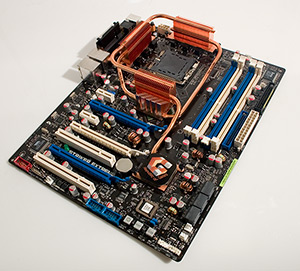Asus Striker Extreme Nvidia nForce 680i Motherboard
Motherboard Layout
Layout
The motherboard ships in a molded plastic casing specifically designed for the Striker Extreme, which protects the board during shipment, and also helps minimize wasted space in the retail shipping box. The retail motherboard box also includes another internal box which includes all of the extras, bundled items, manuals, and disks, which helps minimize clutter when opening up this item. The retail box also has a see-through window on the side in order to see the board's I/O panel, showcasing the integrated LCD screen as much as possible.

|

|
The board itself doesn't quite look like anything else on the market. Everyone who first sees this motherboard is immediately drawn in by its complex set of weaving copper heatpipes around the CPU socket. While copper heatpipes have been done before, and now are even standard on most high-end motherboards, we have not seen a motherboard with this caliber of heatpipes. There is actually a total of four heatpipes altogether, connected as follows.
- Southbridge to top set of copper thin fins.
- Northbridge to top set of copper thin fins.
- Northbridge to left set of copper thin fins
- Bottom thick fins, set of thin-fins to left and top set of copper thin fins.
Basically, the nForce 680i chipset is throwing heat in every direction through a series of heatpipes, and it's up to three sets of copper thin finned heatsinks to dissipate this heat properly. The Northbridge has three heatpipes to send heat through, which means that Asus is definitely focusing on keeping this chipset cool and overclockable. The top and left set of copper thin fins are also placed on top of the motherboard's VRM components, which also help the motherboard's stability when running high wattage / high heat processors. Each copper base plate is connected to their specific chip via thermal paste.
Asus has kept almost a perfect square around the Intel Socket-775 interface, which means you can use large coolers on this motherboard and it won't interfere with the heatpipes. If you go with the water-cooled/ passively cooled route, Asus includes a small fan which sits on one set of the copper heatsinks to keep from overheating. Basically, the heatpipe system is somewhat reliant on the CPU cooler in order to give it some residual airflow, so if you take the CPU cooler out of the mix (eliminating active airflow), you may run into some heat issues. Then again, if you have a nearby case exhaust fan, you shouldn't have to worry about it. The Striker Extreme will work great with newer cases which have rear and top mounted 120mm exhaust fans, as these fans will sit right next to the top two sets of copper thin finned heatsinks.
As we mentioned in the specs, the Socket-775 interface supports all brands of Intel chips, ranging from older Celeron and Pentium models to the newer Core 2 dual and quad-core chips. Obviously, most people who cough up the cash for a board of this nature will be using it with a Core 2 dual or quad-core processor, so Asus has made sure the board is ready right out of the box. For those who are concerned about platform longevity, the nForce 680i chipset is the first product on the market with support for 1333 MHz FSB based Core 2 processors, which are scheduled to be announced in the next few months. In the short term, this also means excellent overclockability for today's 1066 MHz FSB processors.
Since Intel still doesn't have an on-die memory controller, Nvidia takes control here and it's up to them to provide a decent memory interface. They took the high road for the nForce 590-series chipset, which only officially supported DDR2-667, despite the market quickly moving towards DDR2-800 at the time. They aren't taking that same route this time, as the nForce 680i chipset supports DDR2 speeds up to 1200 MHz. Most high-end enthusiasts are focusing on DDR2-800 and DDR2-1066, which are plentiful on the market today, so again Nvidia is future-proofing their chipset with support for newer speeds. We're seeing the first actual DDR2-1200 modules being announced recently, so perhaps sometime in the future we'll be able to adequately test out this feature. However, for the time being and for our testing, we'll be sticking with good ol' low-latency DDR2-800 modules. The Striker Extreme motherboard supports up to 8 GB of memory, supporting 2 GB modules per slot. However, if you want to use all 8 GB capacity, it's likely that you'll have to use DDR2-667, as 2 GB DDR2-800 modules are nearly impossible to find on the market. The nForce 680i supports dual-channel operation as well, so peak memory bandwidth levels skyrocket up to a theoretical 19.2 GB/s if you're using two or four sticks of DDR2-1200 memory.






